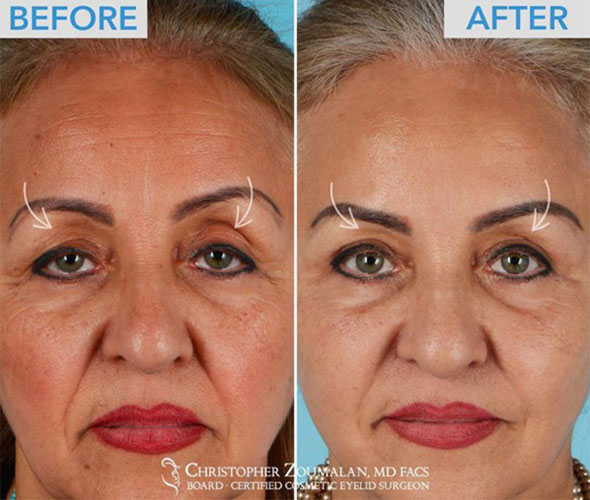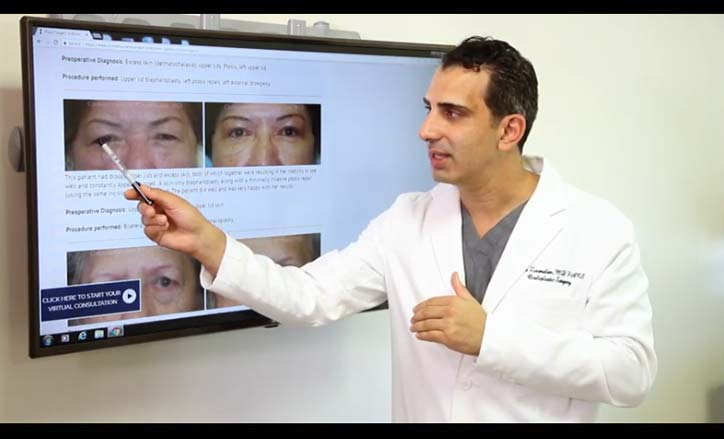Ptosis Surgery
Droopy Eyelids Surgery
Ptosis is the medical term for droopy eyelids, which can occur in one or both lids. Dr. Zoumalan specializes in eyelid surgery, and ptosis surgery is one of the most common eyelid surgeries he performs. Dr. Zoumalan has written numerous book chapters and medical journal publications on the latest techniques in eyelid and ptosis surgery. Dr. Zoumalan has performed thousands of ptosis surgeries, often in combination with cosmetic upper and lower eyelid surgery. Ptosis repair surgery can be done in the office under local anesthesia while the patient is awake, relaxed and very comfortable.Transformation Tuesday before and after PTOSIS SURGERY to improve DROOPY LIDS. Ptosis surgery (aka droopy eyelid surgery) is one of the core procedures we as Oculoplastic surgeon’s perform. I see droopy lids of all sorts in my practice, and they can come from birth (congenital) or acquired in life. I recently took care of a kind gentleman who was significantly bothered by droopy lids, left more so than right. Although he is vibrant and full of life, the droopy lids made him look constantly tired, and unable to see well in his peripheral vision. I was able to perform in an IN-OFFICE PTOSIS SURGERY in both eyes to tighten the muscle internally to improve his lid height AND shape. This is a procedure that when it’s done, will last for many years to come. His after photo was taken a month out from surgery.
Beautiful before and after of an UPPER LID BLEPHAROPLASTY AND PTOSIS REPAIR. This was a tough case where he presented with some fairly significant asymmetry between the two eyes. An upper eyelid surgery was performed to help balance the eyes. His left eyelid’s main issue was ptosis aka droopy eyelid, whereas the right upper lid had excess skin. Two different issues seen in two separate eyelids in the same patient. He underwent an in office procedure to correct both issues at the same time, and here he is just a few weeks out of surgery and looking fantastic already.
Causes of Ptosis:
Ptosis can occur in adults and in children. Adults usually get ptosis as a result of aging and stretching of the eyelid muscles, prior eye surgery which can stretch the eyelid muscles, or even long term contact lens use. Children with ptosis are often born with it and their eyelid muscle is born weak.
There are various different ways to repair a droopy lid and it depends on the type of ptosis and Dr. Zoumalan’s recommendations after a complete oculoplastic exam. Dr. Zoumalan will evaluate you during your consultation and determine what the best type of procedure will be for you. He takes into consideration many factors such as: your eyelid appearance, how droopy your lid is, the amount of extra skin you have draping over your droopy lid, the strength of your eyelid, and whether you have dry eyes or not. Prior photographs are also very helpful to determine what position your lids were prior to them being droopy.
Correcting Ptosis:
Dr. Zoumalan uses a minimally invasive, advanced ptosis surgery technique in many of his patients. Ptosis surgery can often have some residual asymmetries after surgery where one eyelid may still be slightly higher than the other eyelid; Dr. Zoumalan uses this advanced technique to adjust the lid one week out after surgery. Patients often enjoy this added level of measure to help correct for any residual asymmetries. Dr. Zoumalan uses recovery techniques to allow his patients to return to work and their daily activities usually within several days to a week after surgery.
Ptosis surgery can often be combined with other eyelid surgeries such as cosmetic upper and lower lid eyelid surgery or even lower eyelid reconstructive surgery.

Beautiful upper eyelid and brow enhancement from an endoscopic brow lift, and upper eyelid blepharoplasty, and CO2 laser to the lower eyelids. A mini ptosis repair was also performed in the left upper eyelid to balance her upper eyelids. The after photo was taken four months out from surgery. The shape and position of her eyebrows and eyelids was restored while preserving her natural appearance.
Where is the incision made in the upper lids for an upper eyelid ptosis repair?
Dr. Zoumalan will determine if you will require excess skin to be removed from your upper lids in addition to having your lids lifted. If you only require your lids to be lifted and not require any skin to be removed, then Dr. Zoumalan performs a minimally invasive technique to tighten the muscle from inside the upper lid so that no direct incisions are made on your eyelid. If you do require some excess skin to be removed at the same time, Dr. Zoumalan will identify your natural crease carefully, and make a hairline incision over the natural crease. The hairline incision heals well within the natural crease. Dr. Zoumalan pays careful attention to the wound closure using very fine sutures which are removed in 5-6 days.
Why Patients Choose Dr. Zoumalan
Dr. Zoumalan is board-certified by the American Board of Ophthalmology and a member of the American Society of Ophthalmic Plastic and Reconstructive Surgeons (ASOPRS). His practice is tailored to cosmetic and reconstructive oculoplastic surgery.
Dr. Zoumalan will evaluate ptosis through various examination findings and measurements. Dr. Zoumalan will examine not just the eyelids but also the eyebrow position, upper eyelid position, lower eyelid position, the eyes themselves, and the midface (cheekbone area). All these factors are vital in optimizing the surgical outcome. The function of the upper lid muscle (the levator muscle complex) is important when it comes to deciding the type of ptosis surgery to perform.
Children who are born with ptosis, for example, usually have a weakened levator muscle complex and will require a different type of surgery than adults who have acquired ptosis through their adult years. Adults with acquired ptosis usually get it from age related changes to the lid, but Dr. Zoumalan will have to perform a detailed examination to rule out other particular causes.

Beautiful eyelid surgery for this patient . Skin only blepharoplasty combined with a Ptosis repair to open up her droopy eyes. She also had some Fillers done a month out to improve her hollowing! ⭐️ Exclusively Available by Dr. Christopher Zoumalan, Oculoplastic Surgeon

She had droopy upper eyelids and and was unable to see well and also wished to have a procedure to make her appearance look more rested and youthful. She underwent an upper eyelid ptosis repair surgery. A small amount of skin was also removed at the same time through a blepharoplasty incision.

She had longstanding droopy upper lids (ptosis), left eyelid worse than right. A minimally invasive ptosis repair (posterior approach) was performed to help elevate her lids and to allow her to see better. Note the natural looking result.
Important Factors for Droopy Eyelid Surgery
Other important things to consider include a history of dry eyes and prior eyelid surgery, both of which need to be looked at carefully in those particular patients. Dr. Zoumalan does not operate on patients with active dry eye symptoms; dry eye symptoms should be managed and optimized by their eye doctors prior to surgery. Dry eyes symptoms can certainly worsen after ptosis surgery or any eyelid surgery and Dr. Zoumalan carefully monitors for this before and after surgery.
Patients with prior eyelid surgery are also at risk for dry eyes and difficulty closing their eyelids after surgery. Although these risks are minimized with Dr. Zoumalan’s use of minimally invasive surgery and advanced techniques in wound closure, Dr. Zoumalan is very cautious and will monitor the function of the eyelids before and during surgery very carefully.
Combine Brow Lift with Droopy Eyelid Surgery
In cases of low set brows that are worsening the ptosis, patients may need to have a combined brow lift in addition to upper eyelid ptosis surgery repair. There are several types of brow lifting procedures that Dr. Zoumalan performs, and each one is specific to the patient’s desired results, examination findings, age, and gender.
The incisions for the brow lift can either incorporate the existing blepharoplasty incisons (such as brow pexy) or well-hidden small in incisions in the hair-baring scalp areas (such as in temporal brow lift or endoscopic brow lift surgeries). The benefit of combining a brow lift with blepharoplasty is that the brows can be repositioned to a more natural and youthful position. By doing so, less skin is required to be removed in the upper eyelids.

Preoperative Diagnosis: Bilateral upper lid ptosis and brow ptosis
Procedure performed: Bilateral upper lid ptosis repair (blepharoplasty) and external browpexy

Preoperative diagnosis: Bilateral upper lid ptosis, lower lid infraorbital hollowing
Procedure performed: Bilateral upper lid blepharoplasty, hyaluronic acid fillers to her lower lid infraorbital area using Restylane.
Disclaimer:
*Individual results may vary
All before and after pictures displayed are real patients who have consented to having their pictures published on our site. Individual results will vary with each patient and Dr. Christopher Zoumalan does not guarantee any outcomes of procedures shown. All pictures are meant for reference and illustrative purposes only.
Awake Ptosis Repair
With modern ptosis repair techniques, patients now have the option for lighter sedation. Awake ptosis repair allows patients to remain conscious yet entirely comfortable for their procedure. Instead of using general anesthesia, we provide patients a less straining option. Awake ptosis surgery works with only local anesthesia and sometimes light sedation. With this combination, you can reduce the recovery period while still staying comfortable during your surgery. During your consultation, Dr. Zoumalan can discuss this option with you. It is especially ideal for patients who want surgery but cannot have full sedation. Ask us today about awake ptosis repair and how it could benefit you.
What are the symptoms of ptosis?
Dr. Zoumalan uses a minimally invasive, advanced ptosis technique in many of his patients. Ptosis surgery can often have some residual asymmetries after surgery where one eyelid may still be slightly higher than the other eyelid; Dr. Zoumalan uses this advanced technique to adjust the lid one week out after surgery. Patients often enjoy this added level of measure to help correct for any residual asymmetries. Dr. Zoumalan uses rapid recovery techniques to allow his patients to return to work and their daily activities usually within several days to a week after surgery. Ptosis surgery can often be combined with other eyelid surgeries such as cosmetic upper and lower lid eyelid surgery or even lower eyelid reconstructive surgery.
- What should you expect at your preoperative visit for your upcoming revisional eyelid surgery?
- What should you expect on the day of your revisional eyelid surgery?
- What should you expect after your revisional eyelid surgery in terms of recovery and pain control?
- What are the risks and complications to revisional eyelid surgery?
- How do I know if I have ptosis?
- What’s the difference between lazy eye and ptosis?





